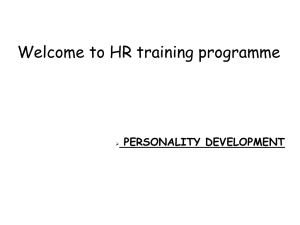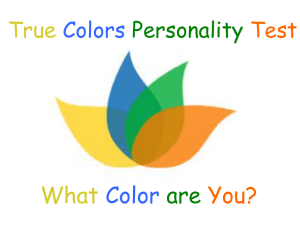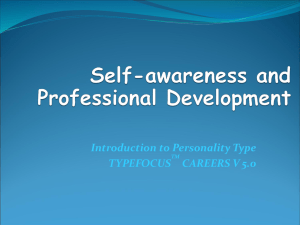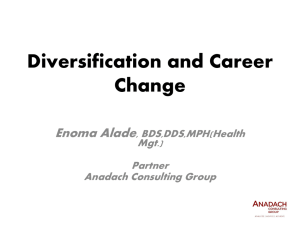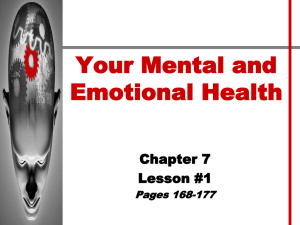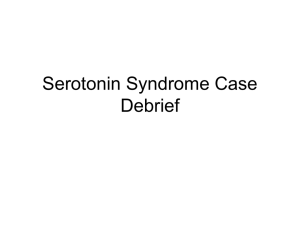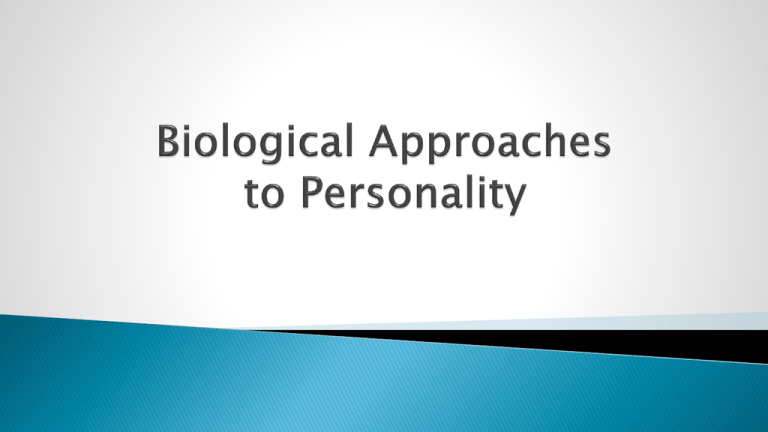
determination of an individual’s characteristics by
interpreting the various irregularities and folds of
the skin
When troubled I seek out
I prefer
The time of my life I favor is
◦ People
◦ Action
◦ Solitude
◦ physical comfort
◦ physical adventure
◦ Privacy
◦ Childhood
◦ Early adulthood
◦ Later years
What would bother me most would be
When in a group I like to
I prefer to
◦ being cut off from other people
◦ being closed off in small places
◦ being exposed to endless noise
◦ Mingle
◦ take charge
◦ take off
◦ let things take their course
◦ do things
◦ observe what is going on
The thing I like most is
◦ eating
exercise
time to myself
The qualities that fit me best are
◦ tolerance and love of people
love of power and leadership
a highly developed self-awareness
Conduct a frequency count of 1, 2, 3s
1 = Endomorph
2 = Mesomorph
3 = Ectomorph
soft body
underdeveloped muscles
round shaped
Associated personality traits:
hard, muscular body, mature appearance
rectangular shaped, thick skin
upright posture
Associated personality traits:
thin, delicate build , young appearance
tall, lightly muscled
stoop-shouldered , large brain
Associated personality traits:
Prior to Accident
capable and efficient
foreman
well-balanced mind
shrewd
business man
After Accident
fitful, irreverent
grossly profane
impatient and
obstinate
lack of emotion
Chimps (1935)
Easily frustrated, vicious
Frontal lobes operated on…
Chimps became mellow
Egas Moniz was present
Procedure then applied to humans
Nobel Prize in 1949
1937 – lobotomy
thalamus-prefrontal cortex incision
Francis Farmer (actress)
Rosemary Kennedy (1941)
Received lobotomy for mood swings
Implication
◦ less emotional, but not emotionally responsive
and future anticipation becomes erratic and
disorganized
◦ Ability to make decisions falls apart
Part of limbic system
◦ Reptilian Brain
Implicated in emotions
When removed:
◦ less aggressive and less fearful
◦ try to eat inedible things
◦ increased sexual behavior
University of Texas (summer, 1969)
Killed wife and mother
14 others killed the next day
Autopsy
tumor next to amygdala
Left
Positive emotions
Damage to:
◦ Schizophrenia
◦ Disorganized
◦ Illogical thinking
Right
Negative emotions
Damage to:
◦ Bipolar Disorder
◦ Mood swings
◦ Energy fluctuations
Hippocrates (460?-377? B.C.)
Galen (A. D. 130 - 200?)
Somatogenic Hypothesis
sanguine, melancholic, choleric, phlegmatic
Primal Qualities:
Dry/Cold
Wet/Warm
Wet/Cold
Dry/Warm
Elements:
Earth
Air
Water
Fire
Seasons:
Autumn
Spring
Winter
Summer
Humors:
Black Bile
Blood
Termperaments:
Melancholic
Sanguine
Phlegmatic
Choleric
Principal Organs:
Spleen
Heart
Brain
Liver
Phlegm
Yellow Bile
descriptions of the four temperaments
traits cluster together
prototypical model of personality
reorganized the four types
two dimensions
◦ degree of emotionality
◦ degree of changeability
dimensional model of personality
Click here for video link
1916 - 1997
Click here
critical of psychoanalysis
at worst – fictional
at best – untestable
700 neurotically maladjusted patients
Reviewed case histories
Developed a two-factor model
used factor analysis - two factors
Neuroticism
Two groups
◦ Disorganized personality, dependency, narrow interests,
dismissal from military service, parental
psychopathology, unsatisfactory home
◦ Neurotically maladjusted (obsessive, anxiety)
◦ Hysterical (physical problems with no physical basis)
negative affect, sleepiness, irritability,
feelings of inferiority, sluggish
heightened right hemisphere activity
use poor coping strategies (i.e., self-blame)
irrational ideas
less able to control their impulses
Two Types of E-I
Introversion
Extraversion
◦ Anxiety, obsessive-compulsive symptoms, reactive
depression neuroses, irritability, apathy, self-conscious,
moody, prone to day dreaming
◦ Hysterical neurosis, bad work history, hypochondriacal,
prone to stammer, accident prone, disgruntled, prone to
aches and pains
introverts prone to:
◦ anxiety-depressive disorders
◦ coined the term “dysthymia”
extraverts prone to:
◦ hysteria-psychopathic disorders
Enter Pavlov
Studies in conditioning
excitatory and inhibitory processes
Establishing a CR due to excitatory processes
Extinguishing CRs due to inhibitory processes
Extraversion
talk more when they meet people
more eye contact
sales, personnel work, nursing and teaching
impulsive
gamble more often
sexual
permissive in their sexual attitudes
higher sex drive
feel good about life
less responsive to punishment
persist in the face of punishment
don't tend to learn from their mistakes
when Es are given a stimulant, they behave like Is
when Is are given an depressant, they tend to act
like Es
Is are more sensitive to stimulation
pupil reaction of Es is slower
nervous system of Is is more sensitive
Excitation
Inhibition
Disorder
Introverts
High (rapid)
Low (slow)
Dysthymia
Extraverts
Low (slow)
High (rapid)
Hysteria
Psychopathology
optimal performance
performance
arousal level
Neurotic Extrovert
performance
arousal level
Easy Task
normal extravert
performance
arousal level
Hard Task
Eysenck proposed in mid 1970s
dimensional
at extreme, psychotic reactions/antisocial
moderate, unusualness and artistic
Polygenic personality trait
“PEN” captured in EPQ
High scores PEN
Impulsivity migrates to P factor
Primary and Secondary Psychopaths
Primary –higher P relative to N
Secondary – higher N relative to P
Psychoticism
Extraversion
Neuroticism
◦ aggressive, cold, egocentric, impersonal
◦ antisocial, unempathic, creative
◦ social, lively, active, assertive,
◦ carefree, dominant, surgent
◦ anxious, depressed, guilt-prone
◦ irrational, shy, moody emotional
Neuropsychologist
Basic theory:
◦ Personality based on the interaction of two systems
Approach
Inhibition
Approach System
Located in the Septal area and the lateral
hypothalamus
Causes one to be sensitive to potential
rewards and to be motivated to seek rewards
Inhibition system
Controlled by septo-hippocampus
Causes one to be sensitive to potential
punishments and to be motivated to avoid
those punishments
Added a third dimension
Flight or Fight system
Controls tendency to be aroused or
aggressive
Controlled by amygdala
Parallel to Eysenck’s “psychoticism”
Dopamine
Serotonin
Norepinephrine
Feeding, drinking, movement
Imbalanced dopamine activity can cause brain
dysfunction and disease.
Schizophrenia and Parkinson's disease
Related to Approach behavior
“Extraversion” and sociability
Parallel with Gray BAS?
“Reward deficiency syndrome”
WWI – patients developed Parkinson’s
Given L-dopa
Catatonic to Normal
Later, to hypomania, restlessness and
grandiosity, to deep depression
Role in inhibition of impulses
Parallel with Gray’s BIS?
Serotonin depletion:
Irrational anger, hypersensitivity to rejection,
pessimism, obsessive worry, fear of risk taking
Serotonin (5HT), many receptor subtypes
Hunger
Aggressive Behavior
Sleep Onset
Depression and OCD
◦ Too little 5Ht, increase in hunger (carbohydrates)
◦ Too little 5HT, violence, antisocial and suicidal behavior
◦ Too much 5HT, causes sleep
◦ Warm milk and turkey contain tryptophan (a precursor to Serotonin)
◦ Too little 5HT
serotonin hypothesis =
used for a variety of disorders
work by raising levels of serotonin by
blocking reuptake
Prozac
Zoloft
Paxil
Luvox
Celexa
Side Effects
weight loss, activating, increased anxiety, nausea,
headaches, sexual dysfunction
Eli Lilly
22 million Americans have used
Cosmetic Psychopharmacology
hormone and neurotransmitter
secreted by the medulla of the adrenal gland
brings about "fight or flight"
increased metabolism, blood pressure, mental activity,
blood flow to the muscles, and heart rate
Also Known As: noradrenaline
High levels
◦ Anger, anxiety, dependent, sociable
Low levels
◦ Disinhibition, impulsivity
◦ Nonconformist, socially detached
Robert Cloninger
Novelty seeking Harm avoidance Reward dependence -
Scan page 21
backs up the nervous system providing
communication and control
network of glands that secrete hormones
hormones are chemical messengers that use
blood as method of transport
Hypersecretion = too much hormone
Hyposecretion = too little hormone
1) solely endocrine (e.g., thyroid)
2) mixed function (e.g., pancreas, thymus)
3) function not entirely known (e.g, pineal)
Regulates metabolism
T3 and T4 are the major thyroid hormones
T4 = thyroxine
characterized by sped-up metabolism,
elevated body temperature, increased
appetite with weight loss, accelerated heart
rate, nervousness, agitation, fatigue and
insomnia
including lethargy, impaired memory,
concentration, feeling cold, constipation,
fatigue
estrogen and testosterone
Linked (indirectly) to aggressive
Males 10 times greater amount
High male testosterone
◦ “Stable extravert”
◦ Sociable, self-acceptance, dominance
◦ Restless energy, smile less
◦ More sexual
High Testosterone Females
◦ Unprovoked violent crimes
◦ Increased sexual interest
◦ Increased sociability, lack of inhibitions
◦ “butch” lesbians (Funder, 2001)
Low Testosterone Females
◦ Less sexual interest






